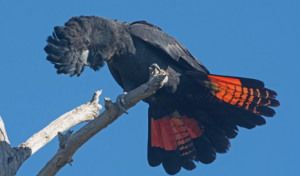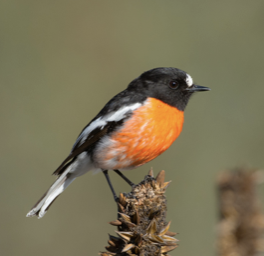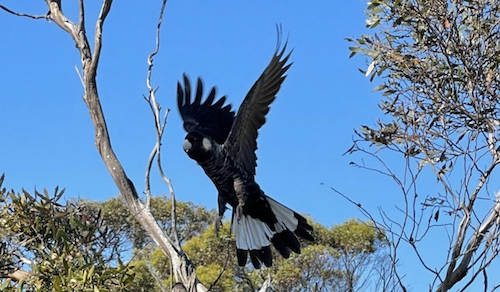by Rodney Marsh
Animals in general, and birds in particular, are often, I believe, ‘messengers of hope’. Over the years, I have had many bereaved people tell me of an unexpected angelic avian visitor (angel = messenger) bringing them comfort, hope and peace following the death of a loved one. In such a way three birds, were a significant feature of my recent Bibbulmun walk. They were, I think, divine messengers to my walking companion and I. Birds accompany and encourage us on our journey through life. So, they too represent God’s presence with us. From conception to dissolution we are never alone, and God is with us and within us (and all things) and so we can and should “apprehend God in all things, for God is in all things” (Eckhart). Here’s my take on three birds who visited us on our Bibbulmun walk.
On the first day we began our walk, our expectations were of an easy 14km stroll to the first hut. We soon, however, struck difficulties – we strayed off the path, found our way again, encountered a  difficult detour and then one unexpected very steep hill. We were walking to the next hut, so we had no alternative but to keep walking, despite these setbacks. Not only that, we didn’t know it at the time, but day two would be much more difficult with many more and steeper hills. Walking has so many parallels with life! There is always the need to keep on keeping on in the face of adversity and turmoil – a long obedience in the same direction (Eugene Peterson). St Paul calls this faithfulness, ‘fortitude’ which is translated by J B Phillips in 1Thess 1:3 as the “sheer dogged endurance in the life that you live” (1Thess 1:3). After our first night in a trekking hut we definitely needed a fortitude top-up. We received just what we needed. The very next morning our hut was visited by a splendid fairy wren, proudly displaying his regal blue plumage in preparation for the spring mating season. He brought an immediate injection of joie de vivre. The message of this messenger: “Glimpse my joy. Share my joy” and since “Joy is the infallible sign of the presence of God” (Pierre Teilhard De Chardin) then God was surely present.
difficult detour and then one unexpected very steep hill. We were walking to the next hut, so we had no alternative but to keep walking, despite these setbacks. Not only that, we didn’t know it at the time, but day two would be much more difficult with many more and steeper hills. Walking has so many parallels with life! There is always the need to keep on keeping on in the face of adversity and turmoil – a long obedience in the same direction (Eugene Peterson). St Paul calls this faithfulness, ‘fortitude’ which is translated by J B Phillips in 1Thess 1:3 as the “sheer dogged endurance in the life that you live” (1Thess 1:3). After our first night in a trekking hut we definitely needed a fortitude top-up. We received just what we needed. The very next morning our hut was visited by a splendid fairy wren, proudly displaying his regal blue plumage in preparation for the spring mating season. He brought an immediate injection of joie de vivre. The message of this messenger: “Glimpse my joy. Share my joy” and since “Joy is the infallible sign of the presence of God” (Pierre Teilhard De Chardin) then God was surely present.
On day two, as on many other days, we saw Mari twigs and chewed honkey nuts (a local term for redgum or Marri nuts) on the path, so we knew there were red-tailed black cockatoos in the forest. We heard their calls, and later caught sight of a group of about a dozen or so of these magnificent birds. We could hear the calls of their  nestlings, but could not sight any nests. Seeing and hearing these birds was a great encouragement to me, because these birds, along with white tailed cockatoos and other parrots, were my childhood companions on the family farm. Almost all these parrots are endangered. But they persist. The redtails reminded me that despite humanity’s best (or worst!) efforts “… nature is never spent;… /Because the Holy Ghost over the bent/ World broods with warm breast and with ah! bright wings.” (Gerard Manly Hopkins), and the redtails certainly have ‘bright wings’! All creation – every ‘thing’ – is a manifestation of the universal energy we sometimes call the ‘Ground of Being’. This mystery is in us and all things. We are all invited to come into contact with, and to discover with ever-increasing depth of experience, “the glorious riches of this mystery, which is Christ in you, the hope of glory” (Col 1:27). My walking companion said of day two, “I myself think of the hills and the grind of getting one foot to move after the other and the relief of getting to the top of repetitive hills.” I, too, needed encouragement to move my feet and the redtail cockeys of day two were that day’s avian angels.
nestlings, but could not sight any nests. Seeing and hearing these birds was a great encouragement to me, because these birds, along with white tailed cockatoos and other parrots, were my childhood companions on the family farm. Almost all these parrots are endangered. But they persist. The redtails reminded me that despite humanity’s best (or worst!) efforts “… nature is never spent;… /Because the Holy Ghost over the bent/ World broods with warm breast and with ah! bright wings.” (Gerard Manly Hopkins), and the redtails certainly have ‘bright wings’! All creation – every ‘thing’ – is a manifestation of the universal energy we sometimes call the ‘Ground of Being’. This mystery is in us and all things. We are all invited to come into contact with, and to discover with ever-increasing depth of experience, “the glorious riches of this mystery, which is Christ in you, the hope of glory” (Col 1:27). My walking companion said of day two, “I myself think of the hills and the grind of getting one foot to move after the other and the relief of getting to the top of repetitive hills.” I, too, needed encouragement to move my feet and the redtail cockeys of day two were that day’s avian angels.
The steep hilly terrain of day two was exhausting. The sun had already descended, but not entirely removed its guiding light, by the time we arrived at the next hut. We were very, very glad to have  arrived. When I shared with my companion about my connection to the redtailed cockeys, he mentioned a bird which was a frequent companion to him and his brothers in their childhood beside the beautiful Porongurups – the scarlet robin. I mentioned that the ‘robin-red-breast’ was also a bird from my childhood nearer the coast. I thought, but didn’t say, “We won’t see one on this walk in the forest”. I was wrong!
arrived. When I shared with my companion about my connection to the redtailed cockeys, he mentioned a bird which was a frequent companion to him and his brothers in their childhood beside the beautiful Porongurups – the scarlet robin. I mentioned that the ‘robin-red-breast’ was also a bird from my childhood nearer the coast. I thought, but didn’t say, “We won’t see one on this walk in the forest”. I was wrong!
As we were taking our first steps out on the last day of our walk a robin red breast flitted across our path – then he was gone. What a gift. Near the beginning and close to the end of our walk, two tiny birds graced us with their presence and in so doing brought us a great gift – a heart knowing that on this journey, as throughout our lives, we are companioned by a high, deep, wide and vast Presence within us and around us always on every step of the way. This presence is important because birds, stones, trees, clouds just are who they are. They find being real easy. Humans don’t. It seems difficult (or impossible) for us to just be. This was Mary Oliver’s experience when, presumably, trying to write, “What’s that you’re doing? whispers the wind” to her. Her response, “Give me a little time, I say back to its staring, silver face./It doesn’t happen all of a sudden, you know”./’Doesn’t it?’ says the wind, and breaks open, releasing distillation of blue iris.” Then her heart that “panics not to be, as I long to be, /the empty, waiting, pure, speechless receptacle.” (Distillation of Blue Iris). A wren, a cockatoo and a robin can only convey their angelic message to an empty, waiting, pure, speechless heart (like Mary Oliver’s surely was). It is my meditation practice the helps me to open my heart to see God in all things.
A question to think about: Meister Eckhart writes “But if I could not have a child with me, I would like to have at least a living animal at my side to comfort me. Therefore, let those who bring about wonderful things in their big, dark books take an animal – perhaps a dog – to help them. The life within the animal will give them strength in turn.” Can humans be fully human without animals and birds or the natural world?

